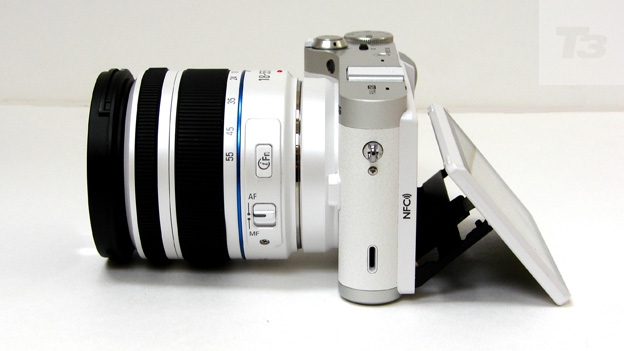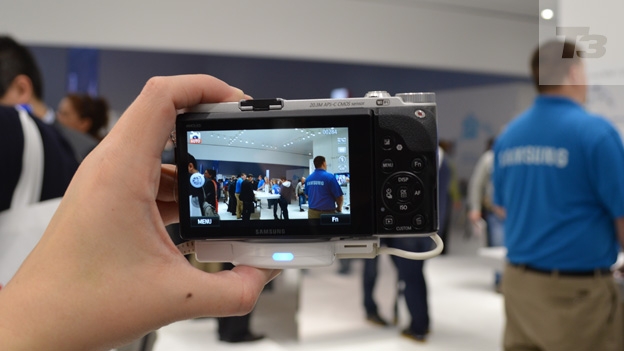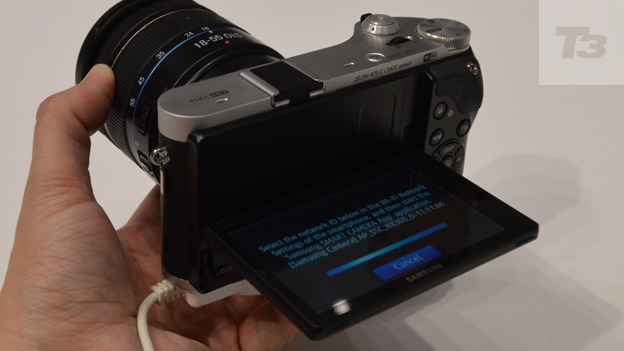Samsung NX300 review
The Samsung NX300 is the brand's new flagship NX Series camera


-
+
Excellent feature set
-
+
Large detail rich sensor
-
+
Tilting touch screen operation
-
-
No built-in viewfinder
-
-
No integral flash
Why you can trust T3












The Samsung NX300 sports a new retro style and a tilting screen but does the larger APS-C size sensor give it an advantage?
The Samsung NX300 is its first interchangeable lens compact system camera since the NX1000, NX210 and NX20 were launched last summer. On first glance it appears to offer the best of all three, in boasting the compactness of the entry level NX1000 and mid-range NX210 with the tilting AMOLED screen ofthe flagship NX20.
This allowed for creative stills and videos from angles we might not otherwise have attempted. Rivals from the Olympus Pen and Sony NEX ranges have offered adjustable screens via a compact chassis for a couple of years, but this is the most compact of the NX range to feature the facility.
Like its forebears, the 20.3-megapixel NX300 has various additional selling points, namely its combination of both a larger APS-C sized sensor as found in consumer digital SLRs, plus Wi-Fi connectivity.
The latter has allowed Samsung to take inspiration from the world of smartphones and christen this a smart camera, with Android and iOS apps available to link it to other 'connected' devices, including Samsung's own tablets and phones.
The larger chip should draw in photo enthusiasts as well as gadget geeks. Thanks to that APS-C sensor, the Samsung's closest rivals remain the Canon EOS M, Sony NEX and Fujifilm X series, arguably the cream of what's currently out there.
The most recent Sony NEX-5 and NEX-6 camera have Wi-Fi too, making them closer competitors still.
While its feature set might be up to the minute, the NX300's styling nods to the past however - though less so on our white version as the retro leather effect that's been newly added to the front is less visible than on the black or brown alternatives.
For the purposes of our review Samsung supplied us with the bog standard 18-55mm iFunction zoom lens, which came with its predecessors and is a good starter option. However the NX300 does come as a kit with a 20-50mm that retails at £599.99 all-in.
And there is an additional point of difference that may appeal to anyone with a 3D telly: a lens that allows users to shoot in both 2D and 3D was announced alongside this Samsung back in January in the NX 45mm f/1.8 2D/3D.
While Panasonic has offered a 3D lens for its Lumix G range for a couple of years, Samsung's is the first that allows the shooting of both 3D stills and video (Panasonic's is 3D stills only), though we're limited to a frame rate of the standard 30fps in 3D as opposed to a maximum 60fps in 2D, while image stabilisation won't work in 3D mode either.
For now though we're only testing how the Samsung handles with the standard 18-55mm option.
Samsung NX300: Controls
Control, shape and layout wise the compact yet curvaceous NX300 shares close DNA with the NX1000 and NX210 models that came six months prior and which themselves shared a blueprint.
As on the NX1000 there's a dedicated Direct Link button for interaction with a smartphone once you've installed the relevant app, while a more expansive Wi-Fi setting is squeezed between the shooting modes on the top plate dial, as was the case with the NX210.
Traditionalists will however be pleased that creative options such as program auto, aperture priority, shutter priority and manual settings have been maintained on the shooting mode dial alongside a scene and subject recognising fully auto option.
That said, the NX300 is roughly half a centimetre wider (as opposed to deeper) than the previous generation, no doubt because of the larger back screen. Here this is presented in 16:9 widescreen ratio rather than the more commonplace, square-ish 4:3.
The camera shoots stills in 3:2 aspect ratio as its default setting, so one side of the screen features a black band which is overlaid with the shooting mode in play, a virtual version of the Direct Link button, plus touch screen options. These include the ability to switch on tracking auto focus, or turn on or off the ability to take a shot by simply tapping the subject on screen.
Though we're given a touch screen - more on which in the following section - this hasn't resulted in a paring down of physical controls. Indeed, as on the touch panel Lumix G models from Panasonic, the control offerings here are comprehensive enough for us to be able to avoid using the screen entirely, if desired.
Rear panel cross keys and dedicated buttons for the likes of menu, delete and playback ensure operation is as fluid as expected. Just about everything we could conceivably want - even ISO, which here runs up to a DSLR-like ISO25600 - falls under finger or thumb. No complaints here then.
Samsung NX300: Screen
As we mentioned in our intro, while the NX300 omits the DSLR-like viewfinder of the NX20, also present on the flagship models of rivals such as Sony's NEX-7 and the Nikon V2, the screen we're reliant on for composition and playback is AMOLED rather than LCD, for better contrast with deeper blacks.
This makes for a more life-like, impact-full appearance when viewing images on the camera itself. Plus, at 3.31-inches the rear plate monitor is larger than most, which is always welcome, as is the respectably huge 768k dot resolution.
Then there's the aforementioned fact that it can be angled and tilted. Really, if you're not bothered about the lack of a traditional eye level viewfinder, this is the very best in compromise.
Another new addition this time around, as mentioned in our section on controls, is the fact that the rear screen is also a touch screen. Again, rivals in the NEX, Lumix G, and Olympus Pen ranges have had this facility for a while.
But its inclusion here makes sense - rather than just being an exercise in bandwagon jumping - while also allowing for a more immersive and intuitive operational experience on the Samsung. The responsiveness of the virtual icons and controls was also as instant as we'd wanted.
Samsung NX300: Battery
As is becoming more commonplace, the NX300ís BP1130 lithium ion cell is (re)charged within the camera, with a USB equipped mains plug and connection lead provided for the purpose rather than a standalone charger.
Get all the latest news, reviews, deals and buying guides on gorgeous tech, home and active products from the T3 experts
This is a means of cutting costs perhaps, but it does also necessitate the camera to be tied up each time the battery is recharged, which means there is less sense in buying a spare battery than there otherwise would be.
Still, with up to 320 shots from a full charge being delivered - which is exactly the same as the performance of the NX1000 - that puts the Samsung right up there with the best of its rivals, such as the Wi-Fi equipped albeit lower resolution Sony NEX-5R, at 330 images.
Samsung NX300: Picture quality
The NX300 doesn't feature an integral flash; instead we get a small clip-on variety as we did with the NX1000 and NX210. This works sufficiently well - in that due to the fact that it's a little bit further away from the lens it avoids the usual blight of red eye in portrait shots.
Can't say we noticed a massive change as a result of the new hybrid AF system in this model compared with its forebears, but certainly the camera is quick off the blocks. The NX300 visibly adjusts focus and exposure for a fraction of a second with a half squeeze of the shutter release button. Press down fully and shot fires off with a satisfying 'clunk' of the shutter.
As mentioned, the default stills ratio is 3:2, as it is on Sony models, so the shots here are slightly wider than the 4:3 ratio anyone upgrading from a point and shoot snapper will expect. This obviously suits landscape shots and group portraits.
As with previous generations of NX with 20 megapixel APS-C chips, resultant images are sharp, clear and colour rich - at least with our all-encompassing 18-55mm kit zoom attached, though we expect prime lenses should perform better still.
As we were given the camera with a manual zoom, obviously the full focal range can be accessed with a simple twist of the wrist when shooting Full HD 1920x1080 pixels video.
If you leave the lens on its auto focus setting the camera will adjust focus for you as you alter framing or zoom in on the subject; though this does mean that the picture will go soft for a second or two while the camera works out what its intended new subject is.
Closer or smaller items can also fool the AF, so if you want complete control and to avoid focus 'drifting', as with a DSLR, manual focusing is once again the way to go.
In terms of transferring images, the camera's built-in Wi-Fi managed to pick up our local network within seconds and we had fired off an email to ourselves direct from the camera within a minute or so. Contrast this with the 20 minutes we spent a couple of months back trying to get the Nikon Coolpix S800c to find our desktop Mac when sat right in front of it.
Samsung NX300: Verdict
While not massively different from its six month old predecessors, Samsung's 20.3 megapixel, Wi-Fi equipped NX300 would appear to be doing everything right - via retro styling yet modern connectivity options and large APS-C sensor for DSLR-like results.
Even if some of its ideas don't come across as wholly original in that we've seen them before on competing brands, it does mean that there are very few negatives indeed. And, save for built-in viewfinder or flash, we get everything a consumer-level CSC user could conceivably want in one unit.
This immediately makes the NX300 worth seriously investigating by anyone upgrading from a snapshot camera, who won't have already invested in lenses and accessories from another competing CSC system. Samsung's NX system, like most others save Olympus and Panasonic, is ring-fenced.
If you already have a Samsung tablet, phone and assorted other gubbins, though it lacks the familiar Android OS of the Galaxy Camera, adding the NX300 to your set up makes even more sense. And indeed this is what its maker will be counting on.
Samsung NX300 release date: Available now.
Samsung NX300 price: £599.99 as a kit with 20-50mm lens

Gavin Stoker has been writing about photography and technology for the past 20 years. He currently edits the trade magazine British Photographic Industry News - BPI News for short - which is a member of TIPA, the international Technical Imaging Press Association.